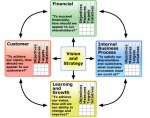 Time is what most SME’s lack; often time needed to monitor business performance. Balanced scorecards save time and enable SME’s to analyse their performance metrics in seconds – essential information to make decision making more effective. (Click on the image to make it bigger).
Time is what most SME’s lack; often time needed to monitor business performance. Balanced scorecards save time and enable SME’s to analyse their performance metrics in seconds – essential information to make decision making more effective. (Click on the image to make it bigger).
Once the domain of large businesses, balanced scorecards can now easily be implemented by SME’s and not for profits. The internet has transformed how performance information can be graphically represented and then communicated throughout an organisation.
And the benefit is the ability to transform an organisation’s strategic plan from a passive document into something updated and communicated on a regular basis and a powerful day-to-day measure of success to help Managers perform.
It has the power to measure far more than the figures, getting right to the DNA of an organisation. Yet it’s a relatively straightforward process to set up and once in place provides invaluable information about the organisation’s progress.
Generally speaking, four perspectives are used. These are:
Learning & Growth – covering employee training and attitudes related to both individual and corporate self-improvement.
Business Process – exploring the internal business processes. The goal is to provide managers with information to confirm that the business is running well.
The Customer – looks at customer focus and satisfaction, crucial markers of an organisation’s success. Poor performance here often indicate future decline.
The Finances – communicates traditional financial information such as, sales, cash flow, forecasts etc. You can also cover risk assessment and cost-benefit data.
To set up a balanced scorecard, having set the organisation’s strategy and direction, the questions to ask are, “What do I need to know to …..
1. ….keep travelling in the right direction without deviating
2. ….maintain the appropriate speed
3. ….keep our precious cargo in best condition
4. ….exceed our customer’s expectations so they order more”.
Once the perspectives and metrics have been identified, performance management software can then be used to get the right performance information to the right people at the right time, graphically presented for easy understanding.
Unfortunately, many people believe the balanced scorecard to be a piece of software, this isn’t the case. However, having made the initial time investment, the process can be simple and almost run itself. It doesn’t need to be complicated; the simpler the better in my opinion.



 Posted by jdw
Posted by jdw 

